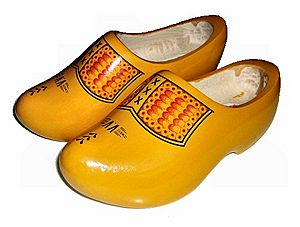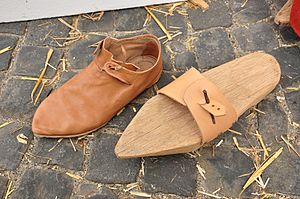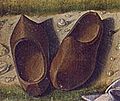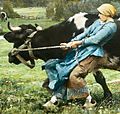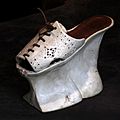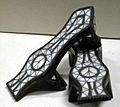Clog (shoe) facts for kids
Clogs are a special type of footwear that are made partly or completely from wood. People wear clogs all over the world. Even though their shape might be different in various cultures, the basic design often stayed the same for hundreds of years in one place.
Traditional clogs are still used today as protective shoes in places like farms and some factories or mines. Sometimes, people think of clogs as old-fashioned or cheap shoes worn by farmers and working people. But actually, some clogs are now seen as fashionable, like Swedish träskor or Japanese geta.
Clogs are also important in different kinds of dance. When dancers wear them, the sound the clogs make against the floor is a big part of the performance. This sound is actually one of the main ideas behind tap dancing!
Contents
What Are the Different Types of Clogs?
The dictionary says a clog is a "thick piece of wood" or a "shoe with a thick wooden sole." Trefor Owen, a traditional clog maker from Wales, explained that there are three main kinds of clogs:
- Clogs with a wooden upper: These are made by carving out a single piece of solid wood to create both the top and bottom parts of the shoe.
- Whole foot clogs: The wooden top covers almost the entire foot, up to the ankle. A good example is the famous Dutch klomp. These are also called "wooden shoes." They can protect your feet so well that they can be used as safety footwear without needing extra strong parts.
- Half-open clogs: The wooden top only covers the toes or a little bit more. Examples include the Italian "zoccolo" or Belgian "sabots." These clogs might have extra straps or coverings made of fabric or leather.
- Clogs with a wooden sole: These clogs only use wood for the bottom part (the sole). The top part can be made of different materials:
- They can have a full top made from leather or similar material, like English clogs. For more protection, they might have steel toe caps or steel pieces inside the soles.
- They can be open, like a sandal. An example is the Japanese geta.
- Some have a small peg for the toe. An example is the Indian paduka.
- Overshoes: These are wooden soles with straps that you wear over your regular shoes to protect them. They were commonly known as pattens. Patten-style clogs are not really used anymore, but modern galoshes (rubber overshoes) are common around the world.
It's important to remember that these types can sometimes mix. For example, some overshoes look like whole foot clogs, like the Spanish albarca. Also, some wooden-soled clogs, like Japanese geta, lift and protect clothing just like overshoes do.
Where Did Clogs Come From?
No one knows exactly when wooden footwear first appeared in Europe. This is because wooden shoes often ended up as firewood, and wood can rot away over time. The oldest wooden shoes found in Europe are from Amsterdam and Rotterdam in the Netherlands. They are from around 1230 and 1280. These old clogs look very similar to the wooden shoes still worn in the Netherlands today!
How Clogs Are Made
For a long time, wooden footwear was made by hand. This meant that the shape of the shoes and how they were made varied a lot from one town or region to another. In the early 1900s, machines started to be used to make wooden shoes. However, after World War II, wooden shoes became less common. People started to prefer more fashionable shoes made entirely of leather or new synthetic materials.
Clogs as Fashion
In the 1970s and 1980s, Swedish clogs became very popular fashion items for both men and women. People often wore them without socks. In the 1980s and 1990s, clogs based on the Swedish style became popular again for women. These were often platform clogs or sandals, with very thick soles that could be as high as 6 or 8 inches! They were worn in many Western countries.
Museums Where You Can See Clogs
- Bata Shoe Museum, Canada
- International Wooden Shoe Museum Eelde, Netherlands
- Bai Mi Wooden Clog Village, Taiwan
- Clitheroe Castle Museum, Lancashire, UK.
Images for kids
-
In this 1883 painting by Fritz von Uhde, painted in the Dutch town of Zandvoort, clogs are shown to be the townspeople's normal footwear.
-
Tengu geta have only one tooth.
-
Belgian sabot from Belgium
-
Træsko from Denmark
-
Sabot from France
-
Holzschuh from Germany
-
Clogs of the North Sea coasts in surf; they are waterproof.
-
Zoccolo from Italy
-
Klumpės from Lithuania
-
Tamanco from Portugal
-
Cantabrian albarcas from Spain
-
Träskor from Sweden
-
Zoggeli from Switzerland
-
Tai-Ping boots from China
-
Paduka from India
-
Bakiak from Indonesia
-
Okobo from Japan
-
Namaksin from Korea
-
Terompah from Malaysia
-
Bakya from the Philippines
-
Nalin from Turkey
See also
 In Spanish: Zueco para niños
In Spanish: Zueco para niños


